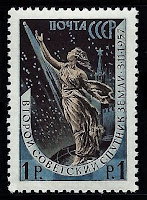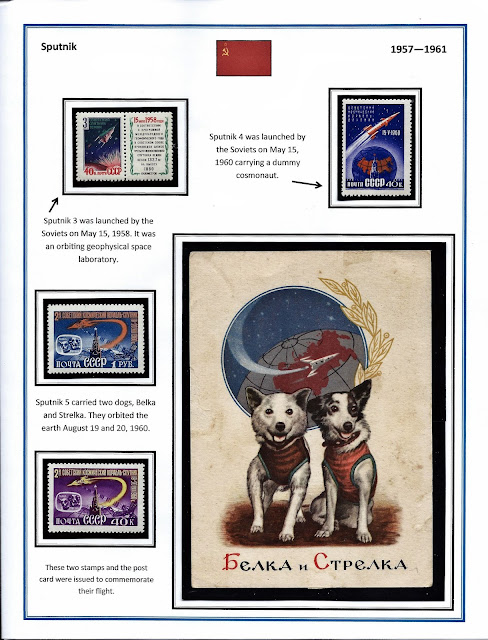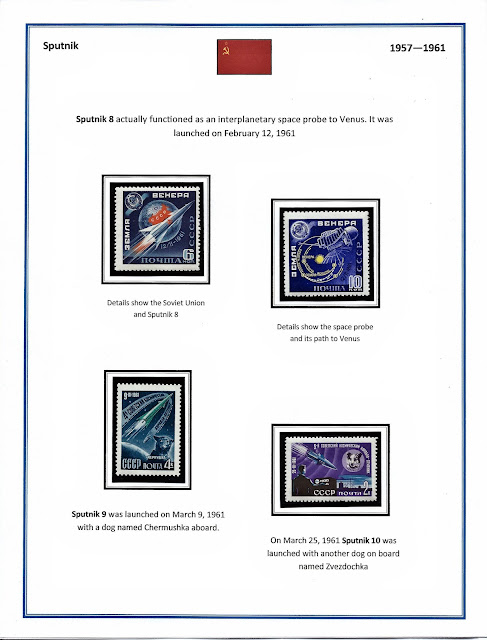I just got my new latest stamp acquisition in the mail today! This sheet is so awesome! If you hold it in the light just right the stamps, which are holograms, show up in three-D! This is a really cool sheet. The title of my space collection is "From Kitty Hawk to the International Space Station". So this stamp sheet is the first stamp in that section and puts the period at the end of my collection. Not the end of my collecting space stamps, but now I have stamps commemorating Kitty Hawk and the International Space Station.
This is my place to talk about my stamp collecting hobby and share some pictures of my stamps.
Welcome to my stamp blog

Feel free to leave comments!
Thursday, September 28, 2017
Wednesday, September 20, 2017
John Glenn Becomes First American Astronaut To Orbit The Earth!
On February 20, 1962 John Glenn became the first American to orbit the earth. His spacecraft was named Friendship 7. Glenn made three orbits of the earth and was in space for four hours and fifty-six minutes.
Monday, September 18, 2017
Gemini Astronauts Honored on Jordanian Stamps
In 1965 Jordan issued a set of stamps to honor the Gemini Astronauts. The three flights were Gemini 6, 7, and 8.
Gemini 6 (December 15, 1965) - Thomas Stafford and Walter Schirra
Gemini 7 (December 4, 1965) - Frank Borman and James Lovell
Gemini 8 (March 16, 1966) - David Scott and Neil Armstrong
I really like these! A nice looking set of stamps!
Friday, September 15, 2017
Gemini 4
Tonight I decided it was time to wave our flag a little bit. So I made the page and mounted my stamps for the Gemini 4 flight on June 3, 1965. The highlight of which was the first American space walk by Edward H. White.
Vostok 3 & 4
And now, here is Vostok 3 & 4...the Soviet Union's first attempt at a rendezvous of two spacecraft in orbit.
Monday, September 4, 2017
SPUTNIK - The Beginning of the Space Race
All right, I decided after posting several links to my Olympic Stamp Pages in my blog on the Stamp Collecting Facebook groups I'm in, I needed to start getting more active in my Space Exploration stamp collection. I haven't done anything with it in years!
So I pulled out my envelope full of space stamps and covers, and my stock albums with stock pages full of space stamps. I put together two or three pages with some stamps that obviously fit together. Then realized I had forgotten a few. Grrr.... I realized I needed to go through and sort all of my space stamps before I try mounting them on pages. Spent two full days doing that! Almost done...
Here is the result of some of my mounting of my space stamps. Cover page first!
In 1955 both the United States and the Soviet Union announced plans to launch artificial satellites. Then on October 4, 1957 the Soviet Union launched Sputnik 1. The satellite's function was to collect air density, temperature, cosmic radiation, and meteoroid data.
This stamp was issued on November 5, 1957 to commemorate the launch of Sputnik 1.
This stamp commemorates the 5th anniversary of the launch of Sputnik 1.
The stamp on the left was produced in 1963 to publish the Soviet Union's space achievements. The one on the right was issued in 1987 to commemorate the 30th anniversary of the Sputnik launches.
The whole page in my album looks like this:
The launching of the Sputnik satellites stunned the United States. Scientists and politicians wondered how America could have fallen so far behind the Soviets in astronautics.
This souvenir sheet was issued to commemorate the 10th anniversary of the launch of Sputnik 1.
On November 3, 1957 the Soviets launched a second satellite, Sputnik 2. It carried a dog named Laika, the first animal to soar into outer space. The satellite's function was to collect biomedical, cosmic radiation, solar x-ray, and ultraviolet data.
This stamp was issued on December 28th, 1957 after the launch of Sputnik 2. The design was the same as the November 5th issue but different in color and larger in size.
This set of four stamps with the design of a symbolic figure greeting the return of Sputnik 2 to earth were issued on November 3, 1957.
The page in my album:
Then Sputnik 3 was launched on May 15, 1958 and was an orbiting geophysical space laboratory.
The label on this stamp give details of the launch.
Sputnik 4 was launched on May 15, 1960 and carried an artificial cosmonaut.
Then on August 19, 1960 Sputnik 5 was launched carrying two dongs, Belka and Strelka. They orbited the earth for two days. These two stamps, and the postcard were issued to commemorate their flight.
And, the page in my album:
Sputnik 8 was launched as an interplanetary space probe to Venus. It was launched on February 12, 1961.
Sputnik 9 launched on March 8, 1961 again carrying a dog, named Chermushka
Album page:
So I pulled out my envelope full of space stamps and covers, and my stock albums with stock pages full of space stamps. I put together two or three pages with some stamps that obviously fit together. Then realized I had forgotten a few. Grrr.... I realized I needed to go through and sort all of my space stamps before I try mounting them on pages. Spent two full days doing that! Almost done...
Here is the result of some of my mounting of my space stamps. Cover page first!
In 1955 both the United States and the Soviet Union announced plans to launch artificial satellites. Then on October 4, 1957 the Soviet Union launched Sputnik 1. The satellite's function was to collect air density, temperature, cosmic radiation, and meteoroid data.
This stamp was issued on November 5, 1957 to commemorate the launch of Sputnik 1.
This stamp commemorates the 5th anniversary of the launch of Sputnik 1.
The stamp on the left was produced in 1963 to publish the Soviet Union's space achievements. The one on the right was issued in 1987 to commemorate the 30th anniversary of the Sputnik launches.
The whole page in my album looks like this:
The launching of the Sputnik satellites stunned the United States. Scientists and politicians wondered how America could have fallen so far behind the Soviets in astronautics.
This souvenir sheet was issued to commemorate the 10th anniversary of the launch of Sputnik 1.
On November 3, 1957 the Soviets launched a second satellite, Sputnik 2. It carried a dog named Laika, the first animal to soar into outer space. The satellite's function was to collect biomedical, cosmic radiation, solar x-ray, and ultraviolet data.
This stamp was issued on December 28th, 1957 after the launch of Sputnik 2. The design was the same as the November 5th issue but different in color and larger in size.
The page in my album:
Then Sputnik 3 was launched on May 15, 1958 and was an orbiting geophysical space laboratory.
The label on this stamp give details of the launch.
Sputnik 4 was launched on May 15, 1960 and carried an artificial cosmonaut.
Then on August 19, 1960 Sputnik 5 was launched carrying two dongs, Belka and Strelka. They orbited the earth for two days. These two stamps, and the postcard were issued to commemorate their flight.
And, the page in my album:
Sputnik 8 was launched as an interplanetary space probe to Venus. It was launched on February 12, 1961.
Sputnik 9 launched on March 8, 1961 again carrying a dog, named Chermushka
On March 25, 1961 Sputnik 10 was launched, again carrying a dog, named Zvezdochka.
Friday, August 25, 2017
Fun With Philatelic Material - Olympic Gold Medalist to Tarzan!
Sometimes it's fun when I run across philatelic materials that illustrate part of my collection where the subject takes a strange twist. Such was the case with the stamp from the Isle of Man that commemorated Johnny Weismeuller's Olympic achievements in the 1924 and 1928 Olympic Games.
I never new he was an Olympic gold medalist! I knew about him since I was a little boy because my father loved to watch him in his Tarzan movies late at night. He and I would sit together in the dark and watch late into the night on Saturday. Weismeuller's parents were from Banat, Yugoslavia where my father was raised.
Later I found this First Day Cover issued in Romania in 2004 to commemorate his achievements.
I never new he was an Olympic gold medalist! I knew about him since I was a little boy because my father loved to watch him in his Tarzan movies late at night. He and I would sit together in the dark and watch late into the night on Saturday. Weismeuller's parents were from Banat, Yugoslavia where my father was raised.
Johnny Weismeuller was born June 2, 1904 as an ethnic German, the elder son of Peter and Elisabeth, both Banat Swabians. His generally accepted birthplace is in Freiodorf, Austro-Hungarian Empire.
At the age of 9 Johnny contracted polio and at the suggestion of his doctor, took up swimming to help battle the disease. Weismeuller was swimming's first superstar; swimming the 100m freestyle and the 4x200m relay team event at both the 1924 Paris and 1928 Amsterdam Games. He also won gold in the 400m freestyle.
On the cache, postmark, and stamp, this FDC Romania commemorated his Olympic achievements as well as his transition to the Tarzan roles in multiple Hollywood films.
The following postcards were also issued with caches from various Tarzan movie posters.
Thursday, August 24, 2017
Olympic Torch Relay
In contrast to the Olympic Flame proper, the Torch Relay of the modern Olympic Games, which transports the Olympic Flame from Greece to the various designated sites of the Olympic Games, has no ancient precedent and was introduced by Carl Diem at the 1936 Olympic Games in Berlin.
Ghana - 1964 Tokyo Summer Olympic Games
Isle of Man - 1948 London Summer Olympic Games
Cambodia - 1968 Mexico Summer Olympic Games
Turkey - 1964 Tokyo Summer Olympic Games
Austria - 1972 Munich Summer Olympic Games
This is what the page in my album looks like:
While most of the time the Olympic Torch is still carried by runners, it has been transported in many different ways including, by dragon boat in Hong Kong, by airplane, on horseback, and as a radio signal transmitted by satellite to trigger a laser beam to relight the flame. It has even been carried under water by divers, in an outrigger canoe, on a camel, and on the Concorde.
In this souvenir sheet featuring Pierre de Coubertin, the founder of the modern Olympic Games, the stamp shows the Olympic Flame arriving in the Cook Islands, May 31st 2000, being transported aboard a traditional outrigger canoe with islanders dressed in native costumes.
Monsterrat - 1932 and 1984 Los Angeles Summer Olympic Games
Netherlands - 1968 Mexico Summer Olympic Games
Germany - 1952 Helsinki Summer Olympic Games
German Democratic Republic - 1956 Melbourne Summer Olympic Games
And here is the page in my album:
On its first journey to the southern hemisphere the flame was carried by runners from Olympia to Athens. When the torch reached Athens it was transferred to a miner's lamp and put on board the Qantas Airlines Super Constellation VH-EAB Southern Horizon under Captain Andy Young and given safe passage to Darwin, its first stop in Australia. The flight also carried 440 pounds of souvenir mail of which this cover was one of the 33,116 items flown.
The cover was postmarked at Olympia on 2 November 1956, and then received a special back stamp on arrival at the Olympic Stadium in Melbourne on 22 November 1956,
This is the page in my album:
The 1984 Summer Olympics Torch Relay was run from May 8th until July 28th, prior to the 1984 Summer Olympics in Los Angeles. The route covered about 9,300 miles across the United States and involved over 3,600 torch bearers.
This postcard with a First Day of Issue cancellation in Los Angeles, also has the Olympic Torch runner as part of the imprinted stamp. The cache features two Olympic Torch runners handing off the Olympic Torch.
Ghana - 1960 Rome Summer Olympic Games
The 1960 Rome Olympic Games Torch Relay started at Olympia then went through many ancient cities including Pyrgos, Patras, Megara, Eleusis, and Athens, from the Panathinakos Stadium in the Greek capitol, to Syracuse in Italy, and along the Appian Way, the Forums, and on to the Olympic stadium.
And finally, this is what the page looks like in my album.
My collection of Olympic Torch Relay stamps and pages will continue to grow as a unique subset of my collection, and part of the Olympic Games story told in stamps.
Subscribe to:
Comments (Atom)




































































